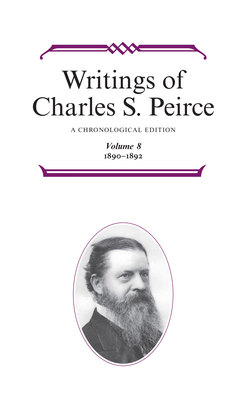Читать книгу Writings of Charles S. Peirce: A Chronological Edition, Volume 8 - Charles S. Peirce - Страница 29
Оглавление15
Logical Studies of the Theory of Numbers
| c. 1890 | Houghton Library & Max H. Fisch Papers |
The object of the present investigation is to analyze carefully the logic of the theory of numbers. I especially desire to clear up the question of whether there can be fundamentally different ways of proving a theorem from given premises; and the law of reciprocity seems likely to be instructive in this respect. I also wish to know whether there is not a regular method of proof in the higher arithmetic, so that we can see in advance precisely how a given proposition is to be demonstrated.
I make use of my last notation for relatives. I write li to mean that two objects l and i are connected. These two objects generally pertain to different universes; thus, l may be a character and i a thing. But there is no reason why I should not, instead of li, write (l, i), except that the first way is more compact. A line over an expression negatives it, so that means that l and i are disconnected. I also write lij to signify that l, i and j are connected; thus, l might be a mode of relation; and i and j two objects so related the one to the other.
I use the signs of addition and multiplication as in the modified Boolian calculus. Thus, limj means that l and i are connected and also m and j. While li + mj means that either l and i are connected or else m and j.
I further use the symbols Σ and Π as follows. Σi means that i is something suitably selected from the universe of i’s, while Πi means that i may be anything however taken from the universe of i’s. For example, ΣiΠjlij will mean that an object i can be found such that, taking any object j whatever, i and j are related in the way signified by l. While ΠiΣjlij will mean that any object whatever, i, being taken, an object j can then be found such that i has the relation to j signified by l.
Numbers are characters of collections; or, since every collection may be considered as a class defined as having a certain essential character, we may say that numbers are certain characters of characters. For example, if we write 2l to signify that the collection l is 2 in number, we may write
That is to say, take any collection l, then, either this is not 2 in number, or if it is, take any objects, i, j, k, then either i or j or k does not belong to the collection l, or if they all do, taking any character m whatever, either i and j both possess or both want this character, or if they differ in this respect, taking any character n whatever, either i and k both possess or both want this character, or if they also differ, then taking any character p whatever, j and k either both possess or both want this character. This is merely given as an example of the mode of writing a proposition so as to analyze its meaning completely. We should ordinarily express it by saying that if any objects i, j, k all belong to a collection of two objects, some pair of them are identical. The fact that 2 is the character of a character is shown by its subjacent index, l, appearing on the line, itself having indices, i, j, k.
The comparison of collections with regard to their number depends upon putting their members into correspondence with one another. How, then, shall we write that for every l there is an m? We must say that there is a relation, r, such that every l is in this relation to some m and no two different ones to the same m.
This does not appear to differ from the broader
As an abbreviation for this we may write Glm, that is, there are at least as many m’s as l’s.
